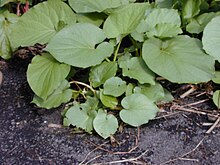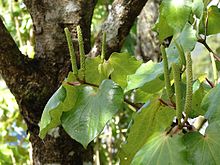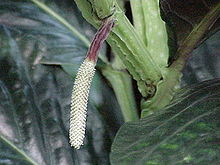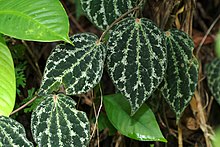Pepper (genus)
| pepper | ||||||||||||
|---|---|---|---|---|---|---|---|---|---|---|---|---|

Black pepper ( Piper nigrum ), illustration |
||||||||||||
| Systematics | ||||||||||||
|
||||||||||||
| Scientific name | ||||||||||||
| Piper | ||||||||||||
| L. |
Pepper ( Piper ) is a genus of the pepper family (Piperaceae). It includes more than a thousand species of various sizes and shapes. Representatives of this genus can be found almost everywhere in the tropics . All species need a warm climate, moist, humus-rich soil and cannot tolerate frost.
description
Vegetative characteristics
The species of the genus pepper are shrubs or trees , which are occasionally semi-herbaceous, rarely climbing; they are often thickened at the nodes . The alternate leaves are simple, with a few exceptions with entire margins, mostly stalked and in a few species they are shield-shaped. Often the adhesion of the leaf blade with the petiole starts a few millimeters deeper on one side than on the opposite side. The upper side of the leaf is smooth to wrinkled or blistered, the underside of the leaf is pitted. The leaves are hairless or barely to densely hairy, the hairs are often rough. There are often sparsely to dense, glandular points on the leaves. The nerve is either palm-like or more frequently pinnate-veined from the lower half to the lower two-thirds, sometimes also completely pinnate-veined. Often fine intersecting connections are formed between the nerves or nerve tracts that merge into one another. The leaf stalks can have different lengths, and they are rarely absent. Usually they are at least at the base, often more or less sheath-like notched up to the leaf blade. The edges of these notches are winged with a narrow or conspicuously wide wing, sometimes it seems to be missing entirely. The stipules are fused with the petioles.
Inflorescences, flowers and fruits

The ear-like inflorescences are opposite the leaves and are cylindrical or, rarely, spherical or almost spherical. They have a diameter of 1 to 10 mm, can occasionally be thicker and have a length of up to 50 cm and more. The length of the inflorescence stalks can be between less than 5 mm and a few centimeters. The axis of the inflorescence between the flowers is usually somewhat grooved, the grooves are flat and smooth or warty to frayed. The flowers are often crowded in the armpits of variously shaped bracts , which are sometimes hairless, but usually tomentose or fringed. The sessile flowers are hermaphroditic in the American species, incomplete (unisexual) in the ancient world. Most of the species are dioecious ( dioecious ), more rarely monoecious ( monoecious ), separate sexes. There are two to five stamens in the male and hermaphrodite flowers . Two to five carpels have grown together to form an upper ovary with two to five stigmas . These are round to thread-shaped, perched or standing on a short and thick to elongated and slender stylus . The stone fruit-like , sessile fruits are shaped differently and single-seeded. They have a thin pericarp and a somewhat hardened endocarp .
Systematics and distribution




The genus Piper was established in 1753 by Carl von Linné in Species Plantarum , 1, p. 28 and Genera Plantarum , 5th edition, 1754. Piper nigrum L. was specified as the lectotype species by Albert Spear Hitchcock in 1923 in the American Journal of Botany , Volume 10, p. 513.
There are 1000 to 2000 species in the genus Piper . There are about 60 species in China.
Here is a selection of the types:
- Piper achupallasense Yuncker
- Curved pepper ( Piper aduncum L. ): It is widespread from Mexico to Central America and on the Caribbean islands to tropical South America . It is a neophyte in Florida, Hawaii, Fiji, Java, the Solomon Islands, and Papua New Guinea.
- Piper Equale Vahl
- Piper andreanum C.DC.
- Piper angamarcanum Sodiro
- Piper angustifolium Ruiz & Pav .: It is only found in French Guiana .
- Piper arborescens Roxb. (Syn .: Piper arborescens var. Angustilimbum Quisumbing , Piper kotoense Yamamoto ): He's in Taiwan, Malaysia and the Philippines widespread.
- Piper arunachalensis P.R. Garunel, P.Rethy & Y.Kumar : It wasfirst describedfrom Tibet in 2001.
- Piper asperiusculum Kunth
- Piper attenuatum Buch.-Ham. ex Miq. : It is common from India to Bhutan and the Chinese province of Yunnan .
- Makulan ( Piper auritum Kunth ): It is widespread from Mexico to Central America to Colombia. In Cuba he is a neophyte.
- Piper austrosinense Y.Q.Tseng : It thrives on trees or rocks in forests at altitudes of 200 to 600 meters in the Chinese provinces of eastern and southwestern Guangdong , southeastern Guangxi and Hainan .
- Piper azuaiense Yuncker
- Piper bambusifolium Y.Q.Tseng : It thrives on trees or rocks in forests at altitudes of 300 to 1200 meters in the Chinese provinces of Guizhou , southeastern Hubei , Jiangxi and Sichuan .
- Piper barbatum Kunth
- Piper begoniicolor Trel. & Yuncker
- Betel Pepper or Chew Pepper ( Piper betle L. ): It is grown in Madagascar, Sri Lanka, India, China, Vietnam, Malaysia, Indonesia and the Philippines. The original range is unknown.
- Piper boehmeriifolium (Miq.) Wall. ex C.DC. : It iswidespreadfrom northeast India via Bhutan , Sikkim , Myanmar , Thailand , northern Vietnam to Malaysia and in the Chinese provinces of Guangdong, Guangxi, Guizhou and Yunnan.
- Piper bogotense C.DC.
- Piper bonii C.DC. : It is common in the Chinese provinces of Guangxi, Hainan, Yunnan and northern Vietnam.
- Piper borbonense (Miq.) C.DC. : Voatsiperifery pepper, Bourbon pepper. Endemic to Madagascar.
- Piper brachypodon (Benth.) C.DC.
- Piper brevispicum C.DC.
- Piper bullatifolium Sodiro
- Piper calceolarium C.DC.
- Piper capense L. f. : It is common in Africa.
- Piper cathayanum M.G. Gilbert & NHXia (Syn .: Piper sinense (Champion ex Benth.) C.DC. non Piper sinense Miq. ): It thrives on trees in forests along rivers at altitudes of about 400 meters in the Chinese provinces of Guangdong , Guangxi , southeastern Guizhou , Hainan and Sichuan ( Emei Shan ).
- Piper chaudocanum C.DC. : It is common in Laos , southern Vietnam and Yunnan.
- Piper chinense Miq. : It is only known from the collection of types, probably from Guangdong , and it is probably extinct.
- Piper clathratum Sodiro
- Piper clusii (Miq.) C.DC. : It is common in West Africa.
- Piper crocatum Ruiz & Pav .: It is endemic to Peru.
- Cubeb pepper or tail pepper ( Piper cubeba L. f. ): It occurs in Indonesia.
- Piper damiaoshanense Y.Q.Tseng : It only thrives in damp locations at altitudes of around 700 meters in northern Guangxi .
- Piper densiciliatum Yuncker
- Piper dolichostachyum M.G. Gilbert & NHXia : This endemic thrives in humid locations in forests only in the Xishuangbanna Autonomous District in southern Yunnan .
- Piper echinocaule Yuncker
- Piper eriocladum Sodiro
- Piper flaviflorum C. DC. : It thrives on large trees at altitudes of 500 to 1800 meters only in central and southern Yunnan.
- Ashanti pepper ( Piper guineense Schumach. & Thonn. ): It is widespread in tropical Africa.
- Piper hainanense Hemsl. : It is common in the Chinese provinces of Guangdong, Guangxi and Hainan.
- Piper Hancei Maxim. : It is common in Fujian, Guangdong, Guangxi, Guizhou, Hunan, Yunnan, Zhejiang provinces of China.
- Piper hastularum Yuncker
- Piper hispidum Sw. : It is widespread from Mexico to Central and South America.
- Piper hochiense Y.Q.Tseng : It only occurs in the Chinese Autonomous Region of Guangxi.
- Piper Hong Kongense C.DC. : It is common in the Chinese provinces of Guangdong, Guangxi and Hainan.
- Piper hylebates C.DC.
- Piper hypoleucum Sodiro
- Piper infossibaccatum A.Huang : It only occurs on the island of Hainan .
- Piper infossum Y.Q.Tseng : It only occurs in Tibet.
- Piper interruptum Opiz : It is common in the Philippines, Indonesia and Taiwan.
- Piper kadsura (Choisy) Ohwi : It is common in Japan, South Korea and Taiwan.
- Piper kawakamii Hayata : It occurs only in the northern Philippines and southern Taiwan.
- Piper kwashoense Hayata : It only occurs in southern Taiwan.
- Piper lacunosum Kunth
- Piper laetispicum C.DC. : It is common in the Chinese provinces of Guangdong and Hainan.
- Piper laguna-cochanum Trel. & Yuncker
- Piper lanceifolium Kunth
- Piper lenticellosum C.DC.
- Piper leticianum C.DC.
- Piper lineatum Ruiz & Pavón
- Piper lingshuiense Y.Q.Tseng : It only occurs on Hainan.
- Long pepper ( Piper longum L. ): The home is in Yunnan , China , India and Nepal. She is a neophyte in Sri Lanka and the Philippines. It is grown in China and other countries in tropical Asia.
- Piper lunulibracteatum C.DC.
- Piper macgillivrayi C.DC. ex Seem.
- Piper macropodum C.DC. : It only occurs in Yunnan.
- Kava-Kava ( Piper methysticum G.Forst. ): The home is probably islands in the western Pacific. On other islands in Oceania the species is a neophyte.
- Piper mischocarpum Y.Q.Tseng : The home is China (Yunnan).
- Piper mullesua Buch.-Ham. ex D.Don : It is common in India, Nepal, Bhutan and in the Chinese provinces of Hainan, Sichuan, Yunnan and in Tibet.
- Piper mutabile C.DC. : It is common in North Vietnam and in the Chinese provinces of Guangdong and Guangxi.
- Black pepper or real pepper ( Piper nigrum L. ); Home: maybe India's Malabar coast .
- Piper novogranatense C.DC.
- Piper nubigenum Kunth
- Piper nudibaccatum Y.Q.Tseng : It only occurs in Yunnan.
- Piper obliquum Ruiz & Pavón
- Piper ornatum N.E.Br. ; Home: Sulawesi.
- Piper papillicaule Trel. & Yuncker
- Piper pedicellatum C.DC. : It is distributed from India, Bangladesh, Bhutan, Sikkim, North Vietnam to Yunnan.
- Piper pingbienense Y.Q.Tseng : The home is southeastern Yunnan.
- Piper pinguifolium C.DC.
- Piper pleiocarpum C.C.Chang ex YQTseng : The homeland is southwestern Yunnan.
- Piper polysyphonum C.DC. : It is common in Laos and the Chinese provinces of Guizhou and Yunnan.
- Piper ponesheense C.DC. : The home is Myanmar and Yunnan.
- Piper porphyrophyllum (Lindl.) NEBr. ; Homeland: Malay Peninsula, Kalimantan
- Piper prunifolium C.DC.
- Piper pseudolindenii C. DC. (Syn .: Piper magnificum Trel. ): It occurs from Mexico to Panama.
- Piper puberulilimbum C.DC. : The home is southern Yunnan.
- Piper puraceanum Trel. & Yuncker
- Piper quitense C.DC.
- Java pepper ( Piper retrofractum Vahl ): It is native to Indonesia, Malaysia, the Philippines, Indochina and Guangdong .
- Piper rhytidocarpum Hook. f. : It is common from India and Bangladesh to Tibet.
- Piper rubrum C.DC. : It is common in northern Vietnam and southern Yunnan.
- Piper saigonense C.DC. ; Home: Vietnam
- Piper sarmentosum Roxb. ; Home: India, Indonesia, Philippines, Malaysia, Cambodia, Laos, Vietnam, China.
- Piper semiimmersum C.DC. : It is common in North Vietnam and in the Chinese provinces of Guangxi, Guizhou and Yunnan.
- Piper senporeiense Yamam. : It only occurs on Hainan.
- Piper silvarum Trel. & Yuncker
- Piper sintenense Hatus. : It only occurs in Taiwan.
- Piper sodiroi C.DC.
- Piper stipitiform C.C.Chang ex YQTseng : It only occurs in Yunnan.
- Piper stipulosum Sodiro
- Piper submultinerve C.DC. : It is common in the Chinese provinces of Guangxi and Yunnan.
- Piper suipigua Buch.-Ham. ex D.Don : It is widespread from India via Nepal and Bhutan to Yunnan.
- Piper sylvaticum Roxb. : It thrives in the eastern Himalayas from India, Bhutan, Bangladesh, Myanmar to Tibet and southern Yunnan.
- Piper taiwanense Lin & Lu : The home is Taiwan.
- Piper thomsonii (C.DC.) Hook. f. : It is spread from India via Bhutan to Vietnam and Yunnan.
- Piper tricolor Y.Q.Tseng : It only occurs in Yunnan.
- Piper tsangyuanense P.S.Chen & PCZhu : It only occurs in Yunnan.
- Piper tsengianum M.G. Gilbert & NHXia : It thrives in mixed forests on large trees at altitudes between 2000 and 2300 meters only in Yunnan.
- Piper tumidum Kunth
- Piper umbellatum L .: It is widespread from Mexico, the islands of the Caribbean and across Central and South America. But it also occurs in Africa and Asia as a neophyte.
- Piper unguiculatum Ruiz & Pav .; Home: Peru
- Piper valladolidense Yuncker
- Piper wallichii (Moq.) Hand .-- Mazz. : It is distributed from India, Bangladesh and Nepal to China.
- Piper wangii M.G. Gilbert & NHXia : The home is Yunnan.
- Piper yinkiangense Y.Q.Tseng : It only occurs in western Yunnan.
- Piper yui M.G. Gilbert & NH Xia : The homeland is Yunnan.
- Piper yunnanense Y.Q.Tseng : The homeland is Yunnan.
- Piper zarumanum Trel.
use
For example, the following species are used: betel pepper or chewing pepper ( Piper betle ), cubeb pepper or tail pepper ( Piper cubeba ), long pepper ( Piper longum ), kava kava ( Piper methysticum ), black pepper or real pepper ( Piper nigrum ).
swell
- Yung-chien Tseng, Nianhe Xia, Michael G. Gilbert: Piperaceae. : Piper , p. 110 - online with the same text as the printed work , In: Wu Zheng-yi, Peter H. Raven, Deyuan Hong (Ed.): Flora of China. Volume 4: Cycadaceae through Fagaceae , Science Press and Missouri Botanical Garden Press, Beijing and St. Louis, 1999. ISBN 0-915279-70-3 (Description and Distribution Sections)
Individual evidence
- ↑ a b TG Yuncker: Piper. In: Robert E. Woodson Jr., Robert W. Schery (Eds.): Flora of Panama , Annals of the Missouri Botanical Garden, Volume XXXVII, Number 1, 1950. Pages 3-71.
- ^ Piper at Tropicos.org. Missouri Botanical Garden, St. Louis, accessed August 8, 2014.
- ↑ a b c d e f g h i j k l m n o p q r s t u v w x y Piper in the Germplasm Resources Information Network (GRIN), USDA , ARS , National Genetic Resources Program. National Germplasm Resources Laboratory, Beltsville, Maryland.
- ↑ a b c d e f g h i j k l m n o p q r s t u v w x y z aa ab ac ad ae af ag ah ai aj ak al am an ao ap aq ar as at au av aw ax ay az ba bb bc bd Yung-chien Tseng, Nianhe Xia, Michael G. Gilbert: Piperaceae. : Piper , p. 110 - online with the same text as the printed work , In: Wu Zheng-yi, Peter H. Raven, Deyuan Hong (Ed.): Flora of China. Volume 4: Cycadaceae through Fagaceae , Science Press and Missouri Botanical Garden Press, Beijing and St. Louis, 1999. ISBN 0-915279-70-3
- ↑ a b c d e f Walter Erhardt , Erich Götz, Nils Bödeker, Siegmund Seybold: The great pikeperch. Encyclopedia of Plant Names. 2. Volume, types and varieties. Eugen Ulmer, Stuttgart (Hohenheim) 2008, ISBN 978-3-8001-5406-7 .
Web links
- Description in the woody flora of the Andes of Ecuador. (span.)
- Entry in the Flora of Zimbabwe . (engl.)
- Piper at Tropicos.org. In: Flora of Panama (WFO) . Missouri Botanical Garden, St. Louis
- Piper at Tropicos.org. In: Catalog of the Vascular Plants of Madagascar . Missouri Botanical Garden, St. Louis
- Piper at Tropicos.org. In: IPCN Chromosome Reports . Missouri Botanical Garden, St. Louis











